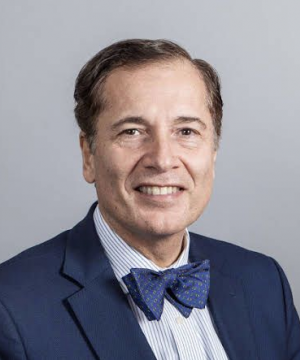
Ophthalmology is a clinical and surgical specialty within medicine that deals with the diagnosis and treatment of eye disorders. A former term is oculism.

Laser-Assisted in Situ Keratomileusis (LASIK), commonly referred to as laser eye surgery or laser vision correction, is a type of refractive surgery for the correction of myopia, hyperopia, and an actual cure for astigmatism, since it is in the cornea. LASIK surgery is performed by an ophthalmologist who uses a laser or microkeratome to reshape the eye's cornea in order to improve visual acuity.

Refractive surgery is optional eye surgery used to improve the refractive state of the eye and decrease or eliminate dependency on glasses or contact lenses. This can include various methods of surgical remodeling of the cornea (keratomileusis), lens implantation or lens replacement. The most common methods today use excimer lasers to reshape the curvature of the cornea. Refractive eye surgeries are used to treat common vision disorders such as myopia, hyperopia, presbyopia and astigmatism.

José Ignacio Barraquer Moner was a Spanish ophthalmologist and inventor born in Barcelona who did most of his life's work in Bogotá, Colombia.

Pedram Hamrah is a German-American ophthalmologist and immunologist. He obtained his M.D. from the University of Cologne, Germany.

Gholam A. Peyman is an Iranian American ophthalmologist, retina surgeon, and inventor. He is best known for his invention of LASIK eye surgery, a vision correction procedure designed to allow people to see clearly without glasses. He was awarded the first US patent for the procedure in 1989.
Peter S. Hersh is an American ophthalmologist, researcher, and specialist in LASIK eye surgery, keratoconus, and diseases of the cornea. He co-authored the article in the journal Ophthalmology that presented the results of the study that led to the first approval by the U.S. Food and Drug Administration (FDA) of the excimer laser for the correction of nearsightedness in the United States. Hersh was also medical monitor of the study that led to approval of corneal collagen crosslinking for the treatment of keratoconus. He was the originator, in 2015, of CTAK for keratoconus, patent holder, and co-developer.
Raymond Mark Stein, MD, FRCSC, DABO, is a Canadian ophthalmologist. He practices refractive and cataract surgery. He is the medical director of the Bochner Eye Institute in Toronto, Ontario and Chief of Ophthalmology at the Scarborough General Hospital.
Professor Harminder Singh Dua is an Indian-British medical doctor and researcher. He is the chair and professor of ophthalmology at University of Nottingham and is the head of the Division of Ophthalmology and Visual Sciences. Prior, he was associate professor at the Thomas Jefferson University, Philadelphia, USA when he was invited to chair in Nottingham in April 1994. He earlier did his Graduation in Medicine from Government Medical College and Hospital, Nagpur.
Gerard Sutton is an Australian ophthalmic surgeon and ophthalmologist in Australia and New Zealand. His specialty is laser vision correction, cataract and lens surgery, and corneal transplantation.

Reza Dana is the Claes H. Dohlman Professor of Ophthalmology, senior scientist and W. Clement Stone Clinical Research Scholar at Massachusetts Eye and Ear, Harvard Medical School, and director of the Harvard-Vision Clinical Scientist Development Program.

Theo Seiler is a German ophthalmologist and physicist. He is considered one of the pioneers of refractive surgery.

Farhad Hafezi is a prominent Swiss eye surgeon and researcher. Hafezi first gained recognition as a leading retina researcher in 1994, having been the first to discover a gene responsible for light-induced retinal degeneration. However, he changed his research focus to the cornea in 2003, and it is this work, particularly on corneal collagen cross-linking (CXL), which he helped pioneer, and advanced laser refractive surgery that he is internationally known for today. Hafezi's current clinical and laboratory research is focused on gaining a better understanding of the cornea. His research group at the University of Zurich has three main research foci:

Berthold Seitz is a German ophthalmologist, professor and director of the Department of Ophthalmology at the Saarland University Medical Center in Homburg, Saarland. He is known for his scientific contributions in the fields of cornea transplantation, cataract surgery and artificial lens-calculation after refractive corneal surgery as well as techniques of amniotic membrane transplantation and its histological integration patterns in the cornea.

Noel Alpins is an Australian ophthalmologist who developed the Alpins method of astigmatism analysis used in refractive, corneal, and cataract surgery, used in the research of LASIK.
The Legacy Devers Eye Institute in Portland, Oregon, is one of the few private, non-profit centers for ophthalmological care, research, and training in the United States. The institute is affiliated with Legacy Health, a network of seven hospitals in Portland and Southwest Washington. Legacy Devers includes the Thelma and Gilbert Schnitzer Comprehensive Glaucoma Center.

John Marshall MBE, FMedSci, PhD, DSc, FRCPath, FRSB, FRCOphth(Hon), FRCOptom (Hon), FARVO is a British medical scientist and inventor. Currently he is the Frost Professor of Ophthalmology at the Institute of Ophthalmology UCL and Emeritus Professor King's College London. He is a pioneer of laser eye surgery.

Dimitri Azar is an American ophthalmologist, professor, and businessman who leads Twenty Twenty Therapeutics, a joint venture established by Santen and Verily. Azar has held roles at Novartis and Verily, Alphabet's Life sciences research organization. He served as dean of the College of Medicine at the University of Illinois at Chicago (UIC) from 2011 to 2018.
Anastasios John Kanellopoulos is a Greek-American eye surgeon specializing in corneal transplantation, cornea crosslinking for keratoconus, complicated cataract surgery and complicated glaucoma. Widely known for research and clinical contributions in micro-incision cataract, customized laser refractive surgery and corneal cross-linking propagation and most innovations, reducing corneal transplants for advanced keratoconus.













